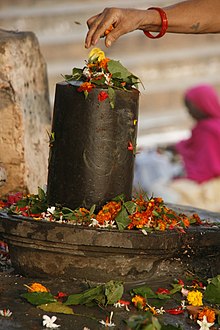Lingam
Aparença


El lingam (o també, linga, ling, Xiva linga, Xiv ling, en sànscrit: लिङ्गं, que significa 'marca', 'signe', 'conclusió'[1][2]) és una representació de la deïtat hindú Xiva usada per al culte en els seus temples.[3] En la cultura tradicional hindú, el lingam és un símbol de l'energia i la potencialitat del déu.[4][4][5][6]
El lingam es representa sovint conjuntament amb el yoni, un símbol de la dea Shakti, l'energia creadora femenina.[7] La unió del lingam i el yoni representa la "indivisible unitat del masculí i el femení, l'espai passiu i el temps actiu, que és l'origen de tota vida".[8]
Referències
[modifica]- ↑ Spoken Sanskrit Dictionary
- ↑ «A Practical Sanskrit Dictionary». Arxivat de l'original el 2012-12-15. [Consulta: 20 gener 2014].
- ↑ Hinduism: Beliefs and Practices, by Jeanne Fowler, pgs. 42–43,
- ↑ 4,0 4,1 Mudaliyar, Sabaratna. «Lecture on the Shiva Linga». Malaysia Hindu Dharma Mamandram. Arxivat de l'original el 2012-06-30. [Consulta: 27 març 2012].
- ↑ Isherwood, Christopher. Ramakrishna and His Disciples. Early days at Dakshineswar: Vedanta Press,U.S., 1983, p. 48. ISBN 978-0-87481-037-0.
- ↑ Sivananda. Lord Siva and His Worship. Worship of Siva Linga: The Divine Life Trust Society, 1996 (web edn. 2000). ISBN 81-7052-025-8.
- ↑ Zimmer, Heinrich Robert. Campbell, Joseph. Myths and symbols in Indian art and civilization. Princeton, New Jersey: Princeton University Press, 1946, p. 126. ISBN 0-691-01778-6. «But the basic and most common object of worship in Shiva shrines is the phallus or lingam.»
- ↑ Jansen, Eva Rudy. The book of Hindu imagery: gods, manifestations and their meaning. Binkey Kok Publications, 2003, p. 46, 119. ISBN 90-74597-07-6.
Bibliografia
[modifica]- Basham, A. L. The Wonder That Was India: A survey of the culture of the Indian Sub-Continent before the coming of the Muslims, Grove Press, Inc., New York (1954; Evergreen Edition 1959).
- Schumacher, Stephan and Woerner, Gert. The Encyclopedia of Eastern Philosophy and Religion, Buddhism, Taoism, Zen, Hinduism, Shambhala, Boston, (1994) ISBN 0-87773-980-3.
- Chakravarti, Mahadev. The Concept of Rudra-Śiva Through the Ages, Delhi: Motilal Banarasidass (1986), ISBN 8120800532.
- Davis, Richard H. Ritual in an Oscillating Universe: Worshipping Śiva in Medieval India. Princeton, New Jersey: Princeton University Press, 1992. ISBN 9780691073866.
- Drabu, V.N. Śaivāgamas: A Study in the Socio-economic Ideas and Institutions of Kashmir (200 B.C. to A.D. 700), New Delhi: Indus Publishing (1990), ISBN 8185182388.
- Ram Karan Sharma. (IAST): Eight Collections of Hymns Containing One Thousand and Eight Names of Śiva. With Introduction and (IAST) (A Dictionary of Names). (Nag Publishers: Delhi, 1996). ISBN 81-7081-350-6. This work compares eight versions of the Śivasahasranāmāstotra. The preface and introduction (anglès) by Ram Karan Sharma provide an analysis of how the eight versions compare with one another. The text of the eight versions is given in Sanskrit.
- Knapp, Stephen. The Heart of Hinduism: The Eastern Path to Freedom, Empowerment and Illumination, Lincoln, Nebraska: iUniverse (2005), ISBN 9780595350759.
- Kramrisch, Stella. The Presence of Siva. Delhi: Motilal Banarsidass, 1988. ISBN 9788120804913.
- Daniélou, Alain. The Myths and Gods of India: The Classic Work on Hindu Polytheism. Inner Traditions / Bear & Company, 1991, p. 222–231. ISBN 0-89281-354-7.
- Versluis, Arthur (2008), The Secret History of Western Sexual Mysticism: Sacred Practices and Spiritual Marriage, Destiny Books, ISBN 978-1-59477-212-2.
